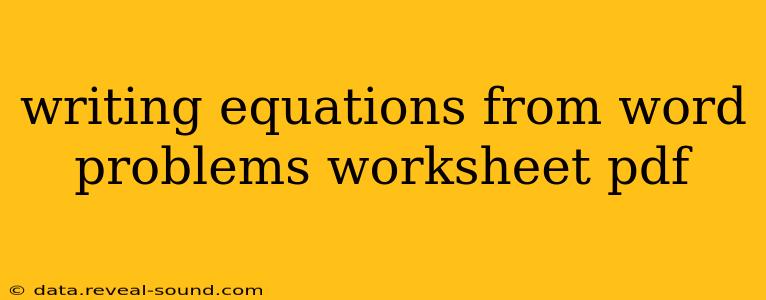Mastering the Art of Translating Word Problems into Equations: A Comprehensive Guide
Many students find word problems daunting, but with the right approach, translating these problems into solvable equations becomes a manageable skill. This guide will walk you through the process, offering strategies and examples to help you confidently tackle any word problem worksheet. We'll cover common problem types and address frequently asked questions to ensure you build a solid foundation in this crucial math skill.
Understanding the Fundamentals:
The key to success lies in breaking down word problems into smaller, digestible parts. Look for keywords and phrases that indicate mathematical operations:
- Addition: "sum," "total," "increased by," "more than," "added to"
- Subtraction: "difference," "decreased by," "less than," "subtracted from," "minus"
- Multiplication: "product," "times," "multiplied by," "of"
- Division: "quotient," "divided by," "ratio," "per"
- Equals: "is," "are," "equals," "results in," "is equal to"
Let's Tackle Some Common Scenarios:
Here are some examples illustrating how to translate word problems into equations. We'll use various problem types to demonstrate versatility and understanding.
1. Age Problems:
-
Word Problem: John is 5 years older than his brother, Tom. The sum of their ages is 23. How old is each brother?
-
Translation: Let 'x' represent Tom's age. John's age is then 'x + 5'. The equation becomes: x + (x + 5) = 23
2. Geometry Problems:
-
Word Problem: The perimeter of a rectangle is 30 cm. The length is 3 cm more than the width. Find the length and width.
-
Translation: Let 'w' represent the width. The length is 'w + 3'. The perimeter formula is 2(length + width). The equation becomes: 2(w + (w + 3)) = 30
3. Money Problems:
-
Word Problem: Sarah has twice as many dimes as nickels. The total value of her coins is $1.20. How many nickels and dimes does she have?
-
Translation: Let 'n' represent the number of nickels. The number of dimes is '2n'. The equation becomes: 0.05n + 0.10(2n) = 1.20
4. Mixture Problems:
-
Word Problem: A chemist needs to mix a 10% acid solution with a 30% acid solution to obtain 100 liters of a 25% acid solution. How many liters of each solution are needed?
-
Translation: Let 'x' represent the liters of 10% solution. The liters of 30% solution is '100 - x'. The equation becomes: 0.10x + 0.30(100 - x) = 0.25(100)
Frequently Asked Questions (FAQs):
What if the word problem involves fractions or decimals?
Don't panic! Treat fractions and decimals exactly as you would whole numbers when setting up the equation. Remember to convert them to decimals or common fractions as needed to simplify calculations.
How do I deal with multiple unknowns?
Sometimes, you might encounter word problems with more than one unknown. In such cases, you might need to create a system of equations to solve the problem, using techniques such as substitution or elimination.
How can I check my answer?
Always substitute your solution back into the original equation to verify its correctness. If the equation holds true, your solution is accurate. Additionally, check if the answer makes sense in the context of the word problem.
Conclusion:
Translating word problems into equations is a skill that improves with practice. By focusing on keywords, understanding the underlying mathematical concepts, and methodically breaking down the problem, you can build confidence and achieve success in solving even the most complex word problems. Remember to use this guide as a reference and tackle a variety of problems from your worksheet to enhance your understanding and proficiency. With consistent effort, mastering this skill will significantly enhance your problem-solving abilities in math.
